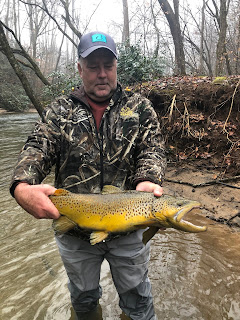Our winter weather pattern continues, as does hope for some angling success. At least it hasn’t been super-cold, with stream temperatures below 40 degrees. That would really curtail trout appetites. Monday night’s 2 inches of rain have already passed and streamflows have returned to normal. My midday stream tour today revealed normal flows, gin-clear water, and nervous fish when the sun is high above them. Saturday looks dry, Sunday will be soggy, and the weekdays are dry until Thursday night. Overall, we have some decent chances to escape and distance ourselves for a mental health afternoon in the woods or on the water.
Our winter fishing pattern continues, too. Dredge deep for trout, especially if it’s cold, and be on the lookout for winter hatches on warm afternoons. Squint to see the tiny winter stones, blue wing olives, and midges in slow seams and eddies. Go slow, study the stream, and let the fish, bugs, and your stream thermometer prescribe your setup. Then rig your rod on a sunny streambank. Aim for smaller bugs right now. If it’s really cold, don’t shy away from some Euronymphing. Just pack a colored sighter, some extra 6x tippet, and a half dozen tungsten Euronymphs in your pocket. Remember that this bottom-dragging technique saved me from a slow day, as described in last week’s report. On the reservoir front, Henry brings us renewed hope, with fish found in open water and along the banks. The hot fly was his Something Else. See his latest report, below. Remember the extra intel in each weekly GAWRD blog, too: https://georgiawildlife.blog/category/fishing/You’ll enjoy the “trout adventure story” link in today’s edition. Here’s this week’s hot fly list and our latest angler reports, as fresh as today! Hot Fly List Wes and Hunter’s hot fly list for this week includes: #10 brown and black rubberleg stones, #12 peach eggs, #16 black hares ear or black copper john, #18 root beer and trout crack midges, #18 pearl lightning bug, #20 gray RS2, and #20 WD40’s in gray, brown, or black. For Euro’s try:#14 walts worm, #16 red tag, and small (16-18) Frenchies and CDC pheasant tails. For dries, carry #16-20 Adams, #20 BWO’s, #18 black stones or caddis, and #22-24 cream and black midges. Headwaters Most headwaters have been a bit slow due to the colder temperatures. The best success has been on the bottom, so try a dry/ dropper rig, but expect few surface eats and use a longer tippet on your weighted prince or pheasant tail to get down to the bottom-huggers. Dukes has fished well for Smithgall reservation holders. Success there is always related to onstream experience. Clear water dictates 6x, tiny nymphs, and lightened reel drags. Dirty runoff allows for heavy tippets, big bugs, big nets, and a good camera!




























